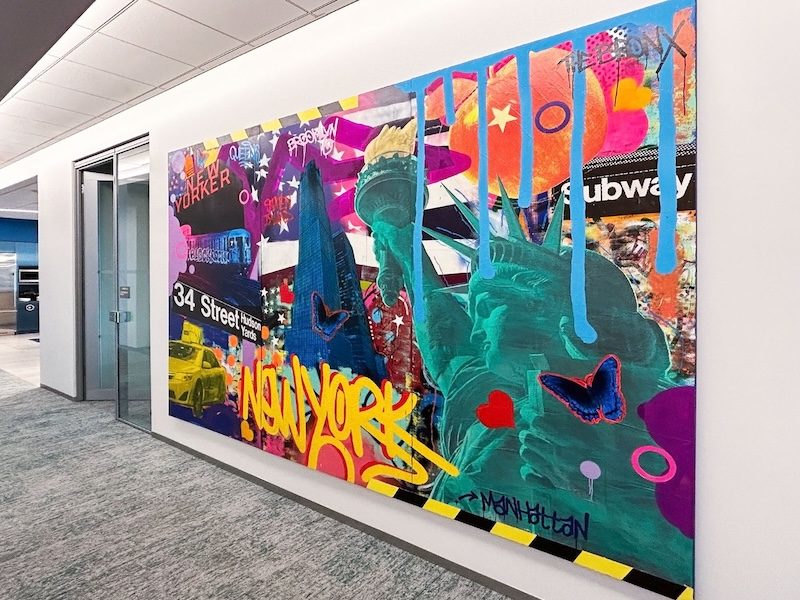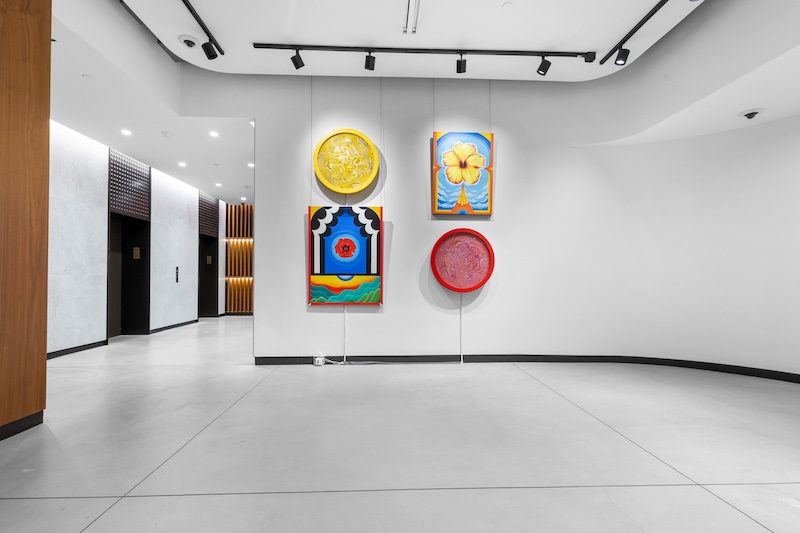Have you ever entered a commercial space, like an corporate office or public venue, and noticed that the art on the walls didn’t seem to connect to the organization’s character? That mismatch can leave visitors and employees feeling disconnected from what makes the brand unique. It’s a missed opportunity to highlight the brand’s identity through well-chosen art. Artwork that closely reflects a company’s style or message draws attention to core brand attributes and strengthens the overall visual environment. Each piece should be chosen with intent, whether it references the company’s founding principles or features the colors and design flourishes that people associate with the organization. Stepping back to plan what goes on the walls makes a difference in how the brand is perceived internally and externally. Below are ten ideas to make art a unifying part of office décor, ensuring that every canvas, print, or installation reflects what the brand represents.
1. Large-Scale Murals with Purpose
Murals offer a substantial visual platform for brand expression. Because they fill a larger area, they bring central themes into clear focus, reminding employees and visitors of the company’s priorities. A well-crafted concept can unify style, brand identity, and practical considerations. Often, the best results come from a concise project plan or creative brief that sets out design direction, intended message, and aesthetic preferences. Once the vision is established, placement in a main hallway or reception area ensures frequent exposure, shaping impressions from the first glance. By bringing these factors together—concept, design, and location—this large-scale art enriches the environment and sparks conversation about what the organization represents.

Concrete Jungle (2023) by Indie 184 merges graffiti style with classic New York references to energize a corporate office environment.
2. Photo Series That Ties into the Brand Story
A photo series can tell a visual story that speaks to your brand’s character in a way scattered images can’t. Rather than hanging random pictures with no unifying theme, you develop a narrative that spans key moments or concepts important to the organization. Before choosing photos, decide on a main purpose—maybe you want to highlight past growth, showcase recent projects, or reveal day-to-day culture. This focus makes it easier to spot images that belong together and arrange them in a sequence people can follow. Once installed, the series becomes a gentle reminder of collective achievements and aspirations, prompting employees or visitors to pause for a moment and reflect on what those scenes represent. Short captions under each photo can fill in gaps for anyone less familiar with the background or to explain certain nuances that might not be readily apparent, so the viewers grasp how every piece fits into the larger story.
3. Commissioned Paintings That Emphasize Brand Themes
Commissioned paintings can help an organization present its identity more directly than off-the-shelf prints or existing art. Through one-on-one discussions, the artist can develop a concept that matches a company’s core values and design preferences, resulting in an original piece that feels uniquely tailored. Selecting an artist with the right style—whether modern, classical, or experimental—ensures the painting fits the broader aesthetic of the space. Colors can connect back to brand guidelines, and thoughtful placement keeps the artwork visible without overpowering other elements.
This process does require more advanced planning. Negotiating a timeline, refining a creative brief, and working out a fair price might be unfamiliar to those who haven’t sourced commissioned work before. An art consultancy can reduce complexity by overseeing the entire project, from finding the right artist to managing installation details. Their networks and expertise make it easier to handle logistics, leaving you with a finished piece that aligns with the company’s values and style without causing headaches along the way.
Originally built as the National Biscuit Company building, 85 Tenth Avenue keeps its original façade while housing top firms in Chelsea. Sam Lasseter’s sculpture, commissioned by atp.art, honors the Oreo’s 1912 beginnings at this historic site.
4. Employee-Created Art Exhibits
Employee-made exhibits can bring genuine personality to the office at a lower cost than purchasing ready-made art. When staff share their own creations, the resulting display often feels more authentic than something generic. The process also encourages a sense of ownership—people take pride in contributing, and colleagues are curious about each other’s talents. This environment may prompt casual conversations around each piece, giving employees an opportunity to learn about one another outside day-to-day tasks.
Clear parameters help things go smoothly. Establish size limits, timelines, and review steps so everyone knows what’s expected. A theme can be broad, like “daily inspirations,” or more specific, such as “memorable achievements.” Once the show is assembled, placing it in an area where people naturally gather—perhaps a break room or lobby—means it gets seen without requiring extra effort. Rotating the artwork every few months ensures that new voices emerge and the content stays interesting. When individuals see their work on display, it boosts morale and reminds everyone that creativity can come from within the team.
5. Reproductions of Historical Artwork Linked to the Brand’s Roots
Historical reproductions can show that the brand stands on a long record of hard work and ideas. By enlarging old patents, marketing materials, or architectural drawings, you remind employees and visitors of a tradition that shapes the present. You can keep a vintage look or update the color scheme to blend with modern décor. Including brief captions helps explain why each piece is relevant, so no one wonders what it’s doing on the wall. Placing these items where people congregate—like hallways or breakout areas—can turn past achievements into daily talking points. For organizations with roots that stretch back decades, this approach can spark appreciation for where things began. It underscores how today’s work extends from decisions and milestones reached over many years, grounding the office in a broader story.
6. Digital Art Installations
Digital installations offer a flexible way to keep brand imagery up to date. Instead of committing to a permanent piece, you can rotate images or brief videos that focus on current projects, new products, or internal milestones. Adding colors and fonts that match existing style guidelines helps everything look consistent. Because these setups rely on screens instead of physical canvases, they require less space, and updating them is as simple as swapping digital files. If you want a more immersive format, short motion graphics can work, though it’s best to avoid turning them into a distraction. Scheduling updates around specific moments—like a product launch or an annual event—means employees and visitors see fresh content without the cost of commissioning new art every time plans change. This approach can spark interest in ongoing developments and serve as a visual reminder of what the organization is currently focusing on.
7. Local Artist Collaborations
Working with a regional artist can shape your visual environment in a way that draws on community culture. Because they often use elements from the area, their pieces pull brand identity together with local references, offering an advantage that out-of-town creators might overlook. Provide brand details—such as color choices or nods to your line of work—so the artist can design a piece that fits the office aesthetic. Hosting a small reception or casual gathering gives employees a glimpse into how local knowledge merges with brand details. Over time, these creative partnerships can become more meaningful than a basic transaction, introducing the company to fresh circles in the surrounding community.
Manhattan Plaza commissioned local artist Marcus Kenney to assemble musical instruments, playbills, and brushes into a sculptural tribute, honoring the dedication behind this neighborhood’s artistic heritage.
8. Sculpture or 3D Installations That Reference Brand Elements
Sculptures or 3D installations add physical depth that two-dimensional works can’t, letting people view brand references from multiple angles. Materials like metal, wood, or recycled elements can reflect what the company does, whether it’s advanced tech or a commitment to environmental goals. Because these pieces occupy real space, placement must be planned carefully. A centerpiece in the lobby or an accent near meeting areas can draw the eye without interrupting daily movement. Observers often pause to talk about what they notice, turning the installation into a topic of interest. By incorporating varied shapes and textures, the brand gains another way to represent its identity beyond the usual flat surfaces. This approach brings a tactile presence that can reinforce key ideas each time someone walks by.
9. Temporary Exhibitions that Rotate Throughout the Year
Rotating exhibitions let you keep the workplace visually fresh without committing to a single display. You can invite local art students, galleries, or emerging creators to bring in new installations at set intervals. If aligning with the brand is a priority, each exhibit can feature a specific theme—perhaps one collection centers on collaboration, while the next addresses environmental awareness. Frequent changes encourage employees to look around more often, and visitors encounter something different each time they drop by. Scheduling ahead is key: confirm that each display meets brand guidelines in style or tone, and let the team know about upcoming transitions. That way, everyone has a chance to explore what’s on view. By treating art as a fluid element instead of a fixed fixture, the office avoids going stale and demonstrates flexibility in how the brand’s ideas appear over time.

Gallery 85 at 85 Tenth follows a rotating schedule, bringing in fresh themes and visuals throughout the year. This private exhibition offers employees and visitors an ever-changing art experience, illustrating how regularly updated displays can keep an office setting lively and engaging.
10. Mixed-Media Walls Incorporating Brand Imagery
Combining different elements on a single wall can showcase the brand from multiple angles without relying on a single piece of art. Vintage ads, older logos, or stylized photos of milestone products often reflect key moments in the organization’s timeline. Consistent color schemes and framing methods keep the overall arrangement looking intentional, whether you choose neat rows or a more playful layout. Because every item is framed separately, it’s easy to add new pieces or remove outdated ones without major renovations. Over time, this evolving collection becomes a visual record of how the brand has grown, giving employees and guests a chance to pause and see what has shaped the company’s identity.
_____
Selecting art for the office doesn’t have to be permanent. Companies evolve, and the visuals on the walls should shift accordingly. A simple check every six months or once a year helps confirm that each piece still speaks to current goals. If your marketing approach, design philosophy, or mission changes, revisiting your art ensures it stays aligned. Employees can offer useful perspectives, spotting the need for updates you might overlook. Even small swaps—rotating a piece or adding a new design element—can energize the space. By keeping office artwork relevant, you show that the workspace reflects ongoing progress rather than remaining stuck in a past version of the brand.
Do you have another approach for weaving brand-focused art into office décor? Feel free to share your thoughts in the comments.
